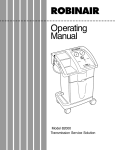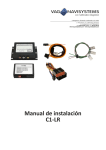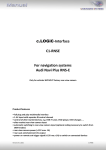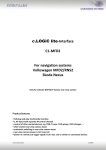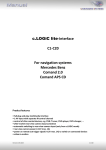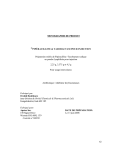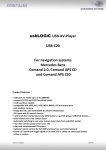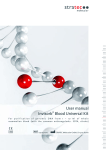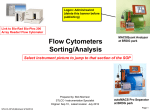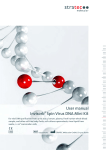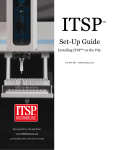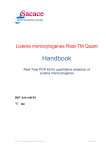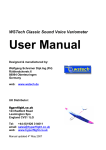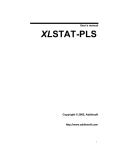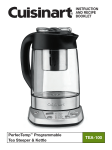Download PDS - BIORON GmbH
Transcript
PureMagic Instruction for Use PureMagic - Food Extraction Kit KIT FOR THE PURIFICATION OF DNA FROM CANNED AND HIGH PROCESSED FOOD OR FROM OTHER PRODUCTS FOR THE SUBSEQUENT ANALYSIS IN REALTIME PCR OR OTHER MOLECULARBIOLOGICAL METHODS Product Size Catalog-no. PureMagic Food extraction 10 preps SBI87010 PureMagic Food extraction 50 preps BI87050 PureMagic Food extraction 100 preps BI87100 PureMagic Food extraction bulk* BIORON GmbH Rheinhorststr.18 - 67071 Ludwigshafen (Germany) Phone +49 621 5720 915 - Fax +49 621 5720 916 [email protected] 06012015IH www.bioron.net Page 1 of 19 PureMagic *Production of an individual bulk for automated applications on request. Please store components immediately after delivery at following conditions: Magnetic beads Proteinase K All remaining components should be stored (2 – 8) °C (-18…- 22) °C (15 – 25) °C Explanation of symbols used in labeling LOT Batch code REF Catalogue number Expiry date Temperature limitation Consult instructions for use Number of tests R 22 – 36 / 38 Harmful S 22 BIORON GmbH Rheinhorststr. 18 67071 Ludwigshafen (Germany) Phone +49 621 5720 915 Fax: +49 621 5720 916 [email protected] BIORON GmbH Rheinhorststr.18 - 67071 Ludwigshafen (Germany) Phone +49 621 5720 915 - Fax +49 621 5720 916 [email protected] 06012015IH www.bioron.net Page 2 of 19 PureMagic Table of Content 1. Introduction .................................................................................................................. 4 2. Specification of the Kit .................................................................................................. 5 3. Components of the Kit and Storage.............................................................................. 6 4. Description of the Method Principle .............................................................................. 7 5. Extraction Protocol ....................................................................................................... 7 6. Procedure for Automated DNA Purification for the KingFisher® Flex ......................... 13 7. Troubleshooting Tips .................................................................................................. 18 BIORON GmbH Rheinhorststr.18 - 67071 Ludwigshafen (Germany) Phone +49 621 5720 915 - Fax +49 621 5720 916 [email protected] 06012015IH www.bioron.net Page 3 of 19 PureMagic 1. Introduction The efficient isolation of DNA of a wide range of interesting specimen becomes more and more an important tool for testing of food and environmental safety. DNA can be used in high sensitive and specific methods like PCR and real-time PCR for the subsequent detection of pathogenic organisms and unacceptable additions in any kind of food. The PureMagic Food Extraction Kit is designed for the isolation of high-quality nucleic acids from a variety of raw and processed food samples. This DNA is suitable for downstream methods like PCR or sequencing. Therefore the possibility of identification of animal components in food and feed is given. Typical applications for PureMagic are species detection in food, cosmetics and pathogen detection in feed and food. The DNA-binding magnetic particles chosen for extraction are optimized for DNA isolation and purification. The high magnetic strength makes them applicable for both manual and automated DNA isolation, e.g. KingFisher Flex (Thermo Fisher Scientific). BIORON GmbH Rheinhorststr.18 - 67071 Ludwigshafen (Germany) Phone +49 621 5720 915 - Fax +49 621 5720 916 [email protected] 06012015IH www.bioron.net Page 4 of 19 PureMagic 2. Specification of the Kit The PureMagic Extraction Kit is designed as a purification system for nearly all types of food and feed samples. This system have been optimized for the isolation of DNA from canned and processed food (e.g. salted, colored and dried food) for the subsequent detection of DNA of animals like pork in the products. In addition, DNA can be purified not only from milk and the co-products such as milk powder, cheese and yoghurt but also the lysis buffer was also tested for extraction of DNA from plant, bacteria and cosmetics (see list below). Food (animal origin) Food (plant origin) Pharmaceuticals Cosmetics Bacteria Others Raw, canned and highly processed products (meat from cow, turkey, chicken, camel, horse, pork, fish) Sausage Milk, Cheese, Yoghurt, Milk Powder, Milk Drinks Vegetable oils, Margarine Breakfast cereals and Muesli Jam Cookies, cakes, biscuits, Jellies, candies, marsh mallows and chocolate products Nutritional supplements like vitamin preparations Animal ingredients in e.g. crèmes, make up, shower gel and body lotion Bacterial DNA from milk and other samples: Enterobacter, Listeria, Staphylococcus Streptococcus Clostridie E.coli Baccilae Gelatine, animal feeding stuff BIORON GmbH Rheinhorststr.18 - 67071 Ludwigshafen (Germany) Phone +49 621 5720 915 - Fax +49 621 5720 916 [email protected] 06012015IH www.bioron.net Page 5 of 19 PureMagic 3. Components of the Kit and Storage The delivery is carried out at RT, so see storage condition as indicated on the bottle or tube. Colour code PureMagic Food extraction 10 preps 50 preps 100 preps Storage at Lysis Buffer 2 x 1,5 ml 1 x 14 ml 2 x 14 ml RT Proteinase K 1 x 11 mg 1 x 55 mg 2 x 55 mg (-18…-22) °C* Green Dilution Buffer for Proteinase K 1 x 600 µl 1 x 3 ml 2 x 3 ml RT Green Wash Buffer Concentrate 1 x 6 ml 3 x 9 ml 6 x 9 ml RT Blue Elution Buffer 1 x 2 ml 3 x 2 ml 6 x 2 ml RT Purple 1 x 1.4 ml 2 x 1.4 ml (2 – 8) °C** Black Magnetic Beads 1 x 300 µl Red RT: Room temperature (15 – 25) °C All PureMagic components have a guaranteed stability and the individual expiry dates are respectively indicated on the labels. * After reconstitution Proteinase K should be stored at (-18 …-22) °C. ** Magnetic beads should be stored at (2 – 8) °C for long-term use. Do not freeze! During shipment or storage in cool ambient conditions, in the Lysis Buffer precipitates may be formed. Dissolve such precipitates by incubating at (40 - 50) °C and gently shaking. For the shipment temperatures up to 30 °C are allowed for a maximum of 7 days. BIORON GmbH Rheinhorststr.18 - 67071 Ludwigshafen (Germany) Phone +49 621 5720 915 - Fax +49 621 5720 916 [email protected] 06012015IH www.bioron.net Page 6 of 19 PureMagic 4. Description of the Method Principle DNA is extracted from homogenized food samples by lysis buffers containing chaotropic salts, denaturing agents and detergents. Subsequently, nucleic acid is bound to magnetic particles using appropriate binding buffer. Magnetic particles are coated with silica, which presents the binding area for DNA and aids as solid support to separate the beads from the solution by a strong magnet. The supernatant can be removed and the DNA which stays on the solid bead can further purified by washing. Nucleic acids are released in Elution Buffer. 5. Extraction Protocol 5.1. General Remarks and Precautions In the following the individual working steps are described in detail. To obtain optimal results, it is recommended to read the instruction completely before starting the examination. Under laboratory standards safety precautions have to be followed Wearing of gloves as well as the application of filter tips is urgently recommended to minimize potential cross contamination. For verification, each examination should be carried out twice (double examination, e.g. prepare two DNA isolates from one sample). In addition a negative extraction control (without sample material) and a positive extraction control (with a known sample) should be carried out in parallel with each DNA isolation. Dispose unused reagents and waste in accordance with country, federal, state and local regulations. Do not use the kit after the expiration date. BIORON GmbH shall have no liability for any direct, indirect, consequential, or incidental damages arising out of the use, the results of use, or the inability to use this product. BIORON GmbH Rheinhorststr.18 - 67071 Ludwigshafen (Germany) Phone +49 621 5720 915 - Fax +49 621 5720 916 [email protected] 06012015IH www.bioron.net Page 7 of 19 PureMagic 5.2. Reagents, Equipment and Consumables supplied by the User Reagents and Solutions • 70 % Isopropylalcohol (= Isopropanol, 2-Propanol, v/v) • 100 % Isopropylalcohol (= Isopropanol, 2-Propanol, v/v) Laboratory Material • Microliter pipettes and sterile filter tips, optional repeater pipette and PD-Tips • 1.5 or 2.0 ml reaction tubes (nuclease-free), all disposables are preferably low-binding • Protective gloves Instruments • Vortex mixer • Thermomixer and optional Rotator • Magnetic stand, e.g. BIORON Diagnostics GmbH Product No. VBE9291 • Analytical Lab Scale • Tabletop centrifuge (capable of 16,000 x g) • Scalpel or disposables like tooth pickers for the food samples 5.3. Before starting • If in Lysis Buffer a precipitate is formed dissolve it by incubating at (40 – 50) °C till solution is clear. • Wash Buffer 10 tests Add 14 ml of 100% Isopropylalcohol to the Wash Buffer before using it for the first time. 50/100 tests Add 21 ml of 100% Isopropylalcohol to the Wash Buffer before using it for the first time. Note: After adding Isopropylalcohol, Wash Buffer is stable for a minimum of 1 year at RT. • Proteinase K is supplied as a lyophilized powder. 10 tests Add 550 µl Dilution Buffer to the lyophilized powder and store the reconstituted Proteinase K at (-18 … -22) °C. 50/100 tests Add 2,75 ml Dilution Buffer to the lyophilized powder and store the reconstituted Proteinase K at (-18 … -22) °C. Note: After reconstitution Proteinase K has a concentration of 20 mg/ml and should be stored at (-18 …-22) °C. • Pre-Heat a thermomixer for incubation at 55 °C (see 5.6.) and later at 65 °C (see 5.8.). • Label all tubes accurately to the laboratory standard. BIORON GmbH Rheinhorststr.18 - 67071 Ludwigshafen (Germany) Phone +49 621 5720 915 - Fax +49 621 5720 916 [email protected] 06012015IH www.bioron.net Page 8 of 19 PureMagic 5.4. Bead Preparation Note: This step is strongly recommended for an optimal binding of the DNA to the beads for the best result 1. For each sample 25 µl Magnetic Beads are used. Calculate the amount of sample plus controls and pipette the whole amount of needed volume to an appropriate tube. E.g. for 10 samples use 250 µl Magnetic Beads 2. Vortex the tube of magnetic beads for 15 – 30 seconds to ensure that the particles are thoroughly a homogeneous suspension. 3. Place the tube with the magnetic beads in a magnetic separator in order to collect the beads to the side of the tube. Wait approximately 30 – 60 seconds until the beads have been attracted to the magnet. The supernatant has to be clear. If not - prolong the time until the supernatant is clear. 4. Discard the supernatant by using pipette with filter tip and then remove the tube from the separator. 5. Re-suspend for each sample the magnetic bead pellet in 75 µl Isopropylalcohol (70 %, v/v). If using the whole amount of magnetic beads pipette the respectively amount of needed volume. E.g. for 10 samples use 750 µl Isopropylalcohol (70 %, v/v) In case of using a repeater pipette in step 5.7. it is recommended to calculate one sample more. E.g. for 10 samples use 825 µl Magnetic Beads (volume for 11 samples) Store at (2 – 8) °C. For optimization of time this step can be done during sample lysis step 5.6. BIORON GmbH Rheinhorststr.18 - 67071 Ludwigshafen (Germany) Phone +49 621 5720 915 - Fax +49 621 5720 916 [email protected] 06012015IH www.bioron.net Page 9 of 19 PureMagic 5.5. Sample Preparation The samples are lysed under denaturing conditions in the presence of Lysis Buffer and Proteinase K. This kit works for following samples, in which sample preparation is different for liquids and nonliquids: Species detection Non-Liquid samples* Liquid samples* Bacterial Analysis go to 5.5.1. go to 5.5.2. go to 5.5.3. * All substances that can be pipetted by means of a microliter pipette are termed “Liquids”. All others are “Non-Liquids” and have to be processed with the “Non-Liquids” procedure. 5.5.1. Non-Liquids and other sample material Weigh 50 mg (± 5 mg) sample material into a 1.5 or 2.0 ml reaction tube, e.g. by using scalpels or tooth pickers. Be aware of cross-contaminations. Proceed with lysis step 5.6. 5.5.2. Liquid samples Vortex the samples thoroughly. Use an amount of 300 µl for all liquids samples. Proceed with lysis step 5.6. 5.5.3. Samples for Bacterial Analyse in liquids/milk products* Pipet 1 ml of the liquid into a 1.5 or 2.0 ml reaction tube, and pellet bacteria by centrifugation for 10 minutes at 5,000 x g. Discard the supernatant and use the pellet for DNA extraction. Proceed with lysis step 5.6. Note: Please avoid pipetting milk clots from milk samples into the reaction tube. BIORON GmbH Rheinhorststr.18 - 67071 Ludwigshafen (Germany) Phone +49 621 5720 915 - Fax +49 621 5720 916 [email protected] 06012015IH www.bioron.net Page 10 of 19 PureMagic 5.6. Sample Lysis 1. Prepare a mix of Lysis Buffer and Proteinase K. For each sample 250 µl Lysis Buffer and 50 µl Proteinase K (LP-mix) is used. Mix well. Add 300 µl of that LP-mix to each sample tube. Calculate a master mix for easier pipetting. 2. Incubate the sample tubes for 1 hour at 55°C and 600 rpm on the thermomixer. Note: The sample should be completely lysed. If necessary prolong the incubation time (no visible particles left, some turbidity is appropriate). 3. Centrifuge the sample for 3 minutes at 16.000x g. 4. Transfer the supernatant (= lysate) into a new reaction tube. Proceed with step 5.7. Note: The presence of fat on top of the supernatant following centrifugation is normal. Remove carefully the supernatant without touching the fat layer. 5.7. DNA Binding 1. Add 350 µl 70 % Isopropylalcohol (v/v) to the lysate and mix well to get a homogeneous suspension. 2. Add 75 µl of the prepared beads (see 5.4.). Mix beads by vortexing before adding them to the sample. Optional: Add the whole amount of prepared beads to the appropriate volume of 70% Isopropylalcohol (v/v). E.g. for 10 samples use 750 µl prepared magnetic beads plus 3500 µl 70% Isopropylalcohol In case of using a repeater pipette it is recommended to calculate one sample more. 3. Mix sample and incubate for 15 minutes on the rotator at 20 rpm or in the thermomixer at 1500 rpm and room temperature to allow the DNA binding to the beads. 4. Place the sample in a magnetic separator in order to collect the beads to the side of the tube. Wait approx. 30 – 60 seconds until the beads have been attracted to the magnet. 5. Discard the supernatant using pipette with filter tip and then remove the tube from the magnetic stand. Proceed with step 5.8. Note: Avoid losing the beads by carefully pipetting and contaminations by using fresh tips. BIORON GmbH Rheinhorststr.18 - 67071 Ludwigshafen (Germany) Phone +49 621 5720 915 - Fax +49 621 5720 916 [email protected] 06012015IH www.bioron.net Page 11 of 19 PureMagic 5.8. Washing Step Contaminants are efficiently washed away using Wash Buffer, while the DNA remains bound to the magnetic beads. 1. Add 500 µl Wash Buffer to the tube and mix well by vortexing. 2. Place the tube in a magnetic separator and leave in place for approx. 30 – 60 seconds to collect the beads. 3. Discard the supernatant by pipetting. Remove as much of the liquid phase as possible and remove the tube from the stand. 4. Add 1000 µl Wash Buffer to the tube and mix well by vortexing. 5. Place the tube in a magnetic separator and leave in place for approx. 30 – 60 seconds to collect the beads. 6. Discard the supernatant by pipetting. Remove as much of the liquid phase as possible after and remove the tube from the stand. 7. Dry the particles at 65°C for 3 minutes (tube with open cap). Proceed with step 5.9. 5.9. DNA Elution Elution Buffer rehydrates the DNA so it will elute from the bead. 1. Add 75 µl Elution Buffer to each sample and vortex. 2. Incubate at 65°C for 5 minutes and 1.400 rpm on the thermomixer. 3. Place the tube in the magnetic separator and leave in place for approx. 30 – 60 seconds to collect the beads. 4. Carefully transfer the eluate to a new reaction tube. The DNA in the eluate is now ready to use. It is recommended to apply the DNA immediately or after storage at (4 – 8) °C over night. Note: If a large amount of DNA is expected, the volume of elution buffer can be increased BIORON GmbH Rheinhorststr.18 - 67071 Ludwigshafen (Germany) Phone +49 621 5720 915 - Fax +49 621 5720 916 [email protected] 06012015IH www.bioron.net Page 12 of 19 PureMagic 6. Procedure for Automated DNA Purification for the KingFisher® Flex ® The following protocol is designed for general use with the KingFisher Flex instrument (96 Deep Well Head). Automation is based on magnetic rods that move particles through the various purification phases including binding, mixing, washing and elution. 6.1. Reagents, Equipment and Consumables supplied by the User Reagents and Solutions • 70% Isopropylalcohol (= Isopropanol, 2-Propanol, v/v) • 100% Isopropylalcohol (= Isopropanol, 2-Propanol, v/v) Laboratory Material • • • • • • Microliter pipettes and sterile filter tips, optional repeater pipette and PD-Tips 1.5 or 2.0 ml reaction tubes (nuclease-free), all disposables are preferably low-binding Protective gloves Microtiter Deep Well (DW) 96 Plate, V-bottom (100 - 1000 µl, Product No. 95040450) KingFisher Flex 96 Tip Comb for Deep Well Magnets (Product No. 97002534) KingFisher Flex 96 KF Plate (Product No. 97002540) Instruments • KingFisher Flex System - 96 Deep Well Head (Product No. 5400630) • • • • • • Rotator Thermomixer at 65 °C Vortex mixer Analytical Lab Scale Tabletop centrifuge (capable of 16.000 × g) Scalpel or disposables like tooth pickers for the food samples BIORON GmbH Rheinhorststr.18 - 67071 Ludwigshafen (Germany) Phone +49 621 5720 915 - Fax +49 621 5720 916 [email protected] 06012015IH www.bioron.net Page 13 of 19 PureMagic 6.2. Before starting • If in Lysis Buffer a precipitate is formed dissolve it by incubating at (40 – 50) °C till solution is clear. • Add 21 ml of 100 % Isopropylalcohol to the Wash Buffer before using it for the first time. Note: After adding Isopropylalcohol, Wash Buffer is stable for a minimum of 1 year at RT. • Proteinase K is supplied in a special formulated storage buffer. After delivery we recommend storage at (-18 … -20) °C. 6.3. Bead Preparation Note: This step is strongly recommended for an optimal binding of the DNA to the beads for the best result 1. For each sample 25 µl Magnetic Beads are used. Calculate the amount of sample plus controls and pipette the whole amount of needed volume to an appropriate tube. E.g. for 10 samples use 250 µl Magnetic Beads 2. Vortex the tube of magnetic beads for 15 – 30 seconds to ensure that the particles are thoroughly a homogeneous suspension. 3. Place the tube with the magnetic beads in a magnetic separator in order to collect the beads to the side of the tube. Wait approximately 30 – 60 seconds until the beads have been attracted to the magnet. The supernatant has to be clear. If not - prolong the time until the supernatant is clear. 4. Discard the supernatant by using pipette with filter tip and then remove the tube from the separator. 5. Re-suspend for each sample the magnetic bead pellet in 75 µl Isopropylalcohol (70 %, v/v). If using the whole amount of magnetic beads pipette the respectively amount of needed volume. E.g. for 10 samples use 750 µl Isopropylalcohol (70 %, v/v) In case of using a repeater pipette in step 5.7. it is recommended to calculate one sample more. E.g. for 10 samples use 825 µl prepared Magnetic Beads (volume for 11 samples) Store at (2 – 8) °C. For optimization of time this step can be done during sample lysis step 6.5. BIORON GmbH Rheinhorststr.18 - 67071 Ludwigshafen (Germany) Phone +49 621 5720 915 - Fax +49 621 5720 916 [email protected] 06012015IH www.bioron.net Page 14 of 19 PureMagic 6.4. Sample Preparation The samples are lysed under denaturing conditions in the presence of Lysis Buffer and Proteinase K. This kit works for following samples, in which sample preparation is different for liquids and nonliquids: Species detection Non-Liquid samples* Liquid samples* Bacterial Analysis go to 6.4.1. go to 6.4.2. go to 6.4.3. * All substances that can be pipetted by means of a microliter pipette are termed “Liquids”. All others are “Non-Liquids” and have to be processed with the “Non-Liquid samples” procedure. 6.4.1. Non-Liquids and other sample material Weigh 50 mg (± 5 mg) sample material into a 1.5 or 2.0 ml reaction tube, e.g. by using scalpels or tooth pickers. Be aware of cross-contaminations. Proceed with lysis step 6.5. 6.4.2. Liquids Vortex the samples thoroughly. Use an amount of 300 µl for all liquid samples. Proceed with lysis step 6.5. 6.4.3. Samples for Bacterial Analyse in liquids/milk products* Use an amount of 1000 µl and centrifuge it for 5 minutes at 5.000 x g. Discard the supernatant and use the pellet for DNA extraction. Proceed with lysis step 5.6. Note: Please avoid pipetting milk clots from milk samples into the reaction tube. BIORON GmbH Rheinhorststr.18 - 67071 Ludwigshafen (Germany) Phone +49 621 5720 915 - Fax +49 621 5720 916 [email protected] 06012015IH www.bioron.net Page 15 of 19 PureMagic 6.5. Sample Lysis 1. Prepare a mix of Lysis Buffer and Proteinase K. For each sample 250 µl Lysis Buffer and 50 µl Proteinase K (LP-mix) is used. Mix well. Add 300 µl of that LP-mix to each sample tube. Calculate a master mix for easier pipetting. 2. Incubate the sample tubes for 1 hour at 55 °C and 600 rpm on the thermomixer. Note: The sample should be completely lysed. If necessary prolong the incubation time (no visible particles left, some turbidity is appropriate). 5. Centrifuge the sample for 3 minutes at 16.000x g. 6. Transfer the supernatant (= lysate) into the according well of the lysate/binding plate. Proceed with step 6.6. Note: The presence of fat on top of the supernatant following centrifugation is normal. Remove carefully the supernatant without touching the fat layer. 6.6. Preparation of Instrument and Plate Set-Up For optimization of time this step can be done during sample lysis step 6.5. Note: Before starting the purification process with the KingFisher® Flex instrument please read carefully the user manual! Resuspend/Vortex the Magnetic Beads thoroughly directly before use! Prefill the Binding Plate, the Washing Plates and the Elution Plate as described below (one well per sample): “Tip Plate” Place the KingFisher Flex 96 Tip Comb for Deep Well Magnets on a Tip Plate (Use one provided KingFisher Flex 96 KF Plate as Tip Plate. These are identical). “Binding plate” prepare a mix of magnetic beads (see 6.3.5.1) and Isopropylalcohol (70%, v/v) and mix well. Add 425 µl of this mix to each well*. Transfer the supernatant (= lysate) into the according well. *Optional: using a repeater or a multichannel pipette “Washing 1+ 2” Add 500 µl and 1000 µl Wash Buffer “Elution” Add 75 µl Elution Buffer BIORON GmbH Rheinhorststr.18 - 67071 Ludwigshafen (Germany) Phone +49 621 5720 915 - Fax +49 621 5720 916 [email protected] 06012015IH www.bioron.net Page 16 of 19 PureMagic Plate Name Tip Plate Plate Type Content Volume/sample Lysate +Isopropylalcohol + beads Wash Buffer Wash Buffer Elution Buffer 350 µl 70 % Isopropylalcohol + 75 µl prepared magnetic beads 500 µl 1000 µl 75 µl KingFisher Flex 96 KF Plate Binding Microtiter DW96 Plate Washing 1 Washing 2 Elution Microtiter DW96 Plate Microtiter DW96 Plate KingFisher Flex 96 KF Plate Follow instructions on the instruments display and load the prefilled plates in the right position. When all plates are loaded, start the program. Note: Ask us for the program with the instrument settings For a seamless processing of samples remember to: (See KingFisher Flex Instrument User Manual for detailed instructions) • Combine the Tip Comb with a Deep Well 96 Plate. Load the plates into the KingFisher Flex® instrument according to the protocol request, placing each plate in the same orientation. Confirm each action by pressing Start. • After sample processing, remove plates as instructed by the instrument’s display. Press Start after removing each plate. • Press Stop after all plates are removed. 6.7. Storage • After finishing the extraction protocol, the Elution Plate contains the extracted DNA. • Use the DNA directly or after storage at (4 – 8) °C over night. • Storage the extracted DNA: Either transfer the DNA into appropriate tubes or keep the eluated DNA in the plate and seal the plate. Note: If the extracted DNA contains carryover of magnetic particles, transfer the DNA into a 1.5 ml reaction tube and centrifuge at maximum speed for 1 minute. Transfer the clear supernatant (contains the DNA) into a new tube. BIORON GmbH Rheinhorststr.18 - 67071 Ludwigshafen (Germany) Phone +49 621 5720 915 - Fax +49 621 5720 916 [email protected] 06012015IH www.bioron.net Page 17 of 19 PureMagic 7. Troubleshooting Tips Problem Cause Corrective action Incomplete lysis Reduce sample volume / weight to 50 %. Prewarm elution buffer to 60 °C. Drying of Wash Buffer may have been incomplete. Prolong the time of collecting the beads (steps binding, washing and elution). We recommend an incubation time up to 2 minutes. Decrease the drying time. Leaving the cap off of the reaction tube during the 65°C drying step for the indicated time to eliminate any residual alcohol. Increase the time of binding on rotator. Make sure Lysis Buffer does not contain precipitates. Make sure beads are sufficiently suspended before pipetting. Incomplete elution Incomplete collection of magnetic beads Over drying of the magnetic beads after washing step Low DNA yield Inefficient binding to the magnetic beads No DNA eluted Not enough magnetic beads were used Before use, Lysis Buffer shows precipitates. Incomplete resuspension of magnetic beads Magnetic beads were aggregated; they were frozen or centrifuged Inefficient cell lysis due to inefficient mixing of Lysis Buffer and sample Wash Buffer was not prepared correctly Eluate is not clear Sample is not completely purified Incubate the buffer by 40 °C – 50 °C. Resuspend the magnetic beads by vortexing before use. Don’t freeze or centrifuge the magnetic particles. Make sure the sample is thoroughly mixed with Lysis Buffer. Prepare Wash Buffer by adding Isopropanol according to instruction. Repeat lysis step. Centrifuge the solution to separate the DNA from the impurities and removing the DNA containing supernatant to a fresh tube. BIORON GmbH Rheinhorststr.18 - 67071 Ludwigshafen (Germany) Phone +49 621 5720 915 - Fax +49 621 5720 916 [email protected] 06012015IH www.bioron.net Page 18 of 19 PureMagic Problem Problem with downstream applications Cause Corrective action DNA is contaminated with inhibiting substances Not enough DNA in the sample Magnetic beads remaining in the eluate Reduce sample volume / weight to 50%. Or Perform PCR with a 1:10 dilution of the eluate with TE or water Quantify the extracted DNA and use sufficient DNA. Perform one more magnetic separation step. BIORON GmbH Rheinhorststr.18 - 67071 Ludwigshafen (Germany) Phone +49 621 5720 915 - Fax +49 621 5720 916 [email protected] 06012015IH www.bioron.net Page 19 of 19



















